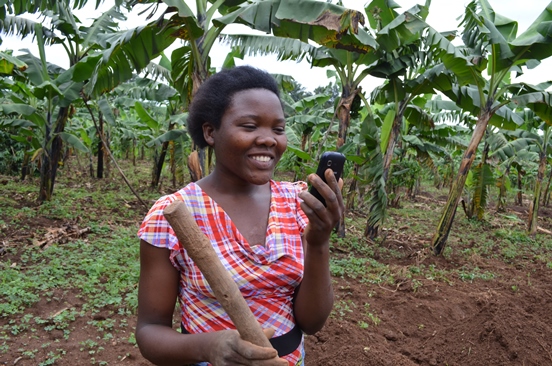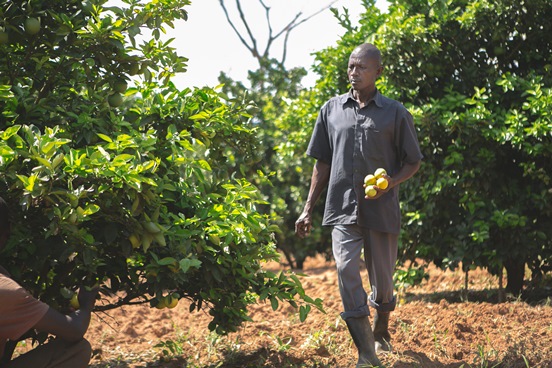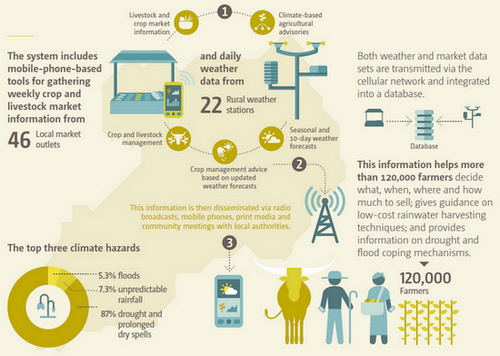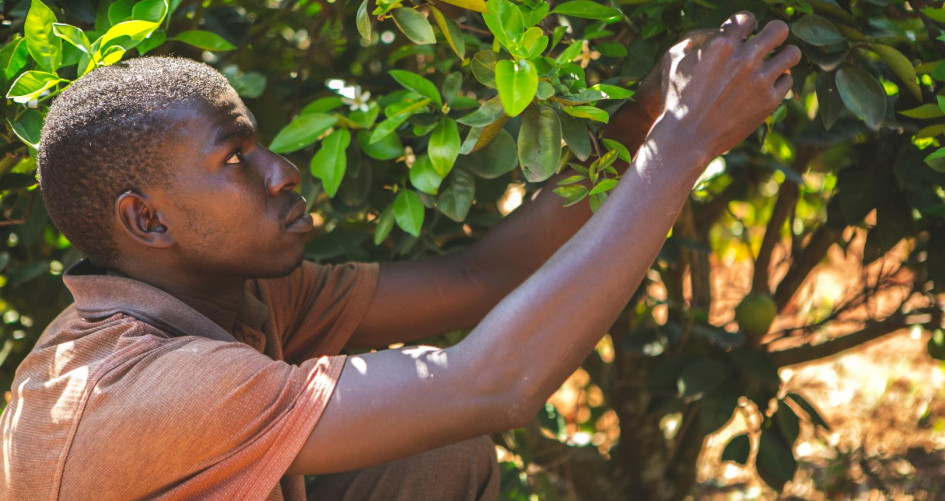This project uses a set of ICT tools to collect, analyze and send out agricultural advisories, crop and livestock market information and weather data to Ugandan farmers, who are among the most affected by the impacts of climate change. More than 100,000 farmers now receive seasonal and short-term weather forecasts, agricultural advisories, weekly livestock and crop market information and guidance on low-cost rainwater harvesting techniques and drought and flood coping mechanisms via mobile-phone technology and interactive radio. As a result, farmers are able to minimize crop loss and damage, making them more resilient to a changing climate.
Key facts:
- More 100,000 farmers receive climate change adaptation information via mobile-phone technology, including seasonal weather forecasts and agricultural advisories tailored to their languages and regions
- As a direct result of the project, crop loss and damage has been reduced by up to 65% (USD 474 – 573 per household per year)
- The project is designed in such a way that it is generic and customizable enough to be easily replicated in other countries

The problem
Agriculture, which accounts for over 40% of Uganda’s GDP, employs 80% of the labor force and supplies 85% of exports, is primarily rain-fed, making it vulnerable to drought. The effects of higher average temperatures and more frequent and severe climatic changes in Uganda are seen primarily in the reduction in food security, decline in the quantity and quality of water and degradation of ecosystems, and negative impacts on health, settlements, and infrastructure.
Yet, farmers here receive little or no relevant information to help them cope with drought and other climatic stresses.

The solution
The project developed a climate information system that uses a set of ICT tools to collect, analyze and disseminate adaptation information to farmers. The system includes mobile-phone-based tools for gathering weekly crop and livestock market information from 46 local market outlets and daily weather data from 22 rural weather stations. This information is then disseminated via radio broadcasts, mobile phones, print media and community meetings with local authorities.
This information helps more than 100,000 farmers decide what, when, where and how much to sell; gives guidance on low-cost rainwater harvesting techniques; and provides information on drought and flood coping mechanisms.
Farmers can ask questions or request additional information via text message. Interactive radio talk-shows allow farmers to phone in or text questions or comments live on-air.
Both weather and market data sets are transmitted via the cellular network and integrated into a database on a server installed by the project at the Meteorology Authority in Kampala, where the weekly reports are generated. Forecasters at the Meteorology Authority have access to daily rainfall data on a secure website developed by the project.
Helping people
Crop and livestock market information helps farmers decide what and where to sell, and minimizes economic losses  incurred by selling their assets below market value.
incurred by selling their assets below market value.
Climate-based agricultural advisories such as crop planning advice; crop management advice based on updated weather forecasts and how it will affect sowing, weed management, pest and disease incidence and control, harvest and post-harvest handling of crops; and crop and livestock management under unfavorable weather conditions such as heavy rains, floods and strong winds helps farmers minimize crop loss and damage.
A study involving 640 households showed that the use of timely and locally relevant adaptation information reduced crop loss and damage by 67% (USD 474 - 573 per household per year).
Spillover effect
The project is designed in such a way that it is generic and customizable enough to be replicated in other countries. To support replicability, the core part of the system, including the SMS engine, reporting modules, data collection and transmission platform, do not change when deployed in different setting. All components of the system are based on widely used open-source applications and can be used by any institution/country without the need to obtain licenses and subscription fees.
The project is developing documentation to enable the customization of the system by interested parties including the ability to reconfigure the user interfaces, user rights and privileges, external interoperability points, administrative and user management options, and adding additional modules without changing the core elements of the system.





Images owned by the activity partners, all rights reserved.

